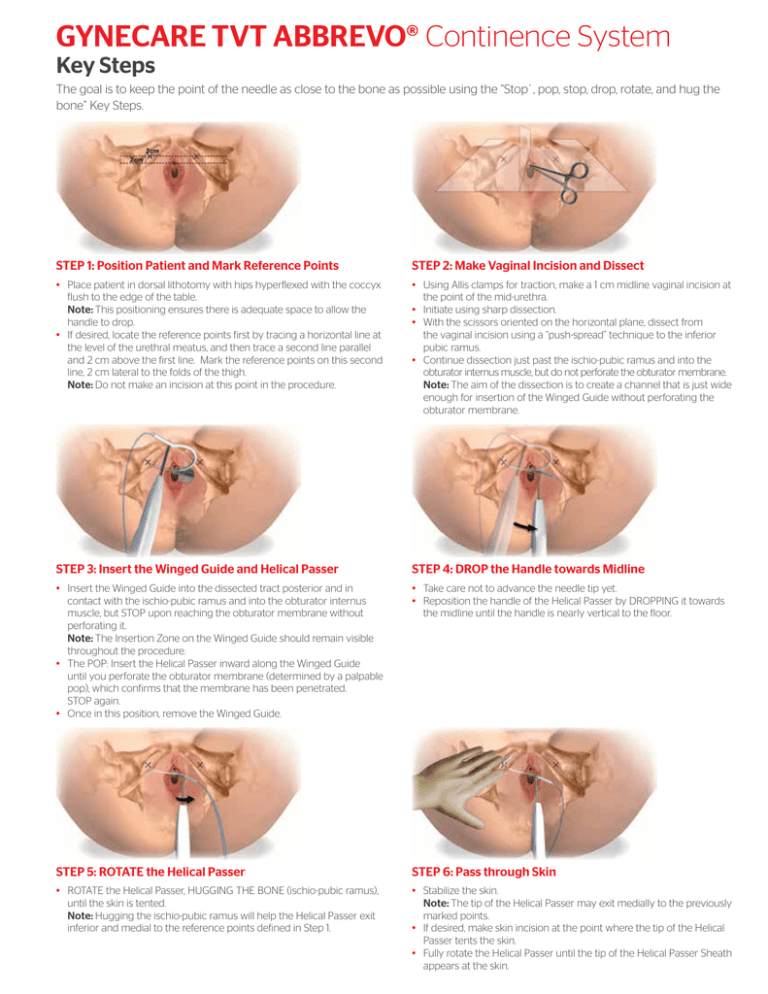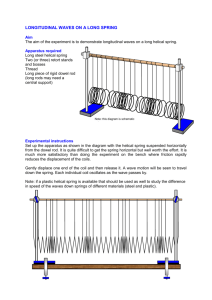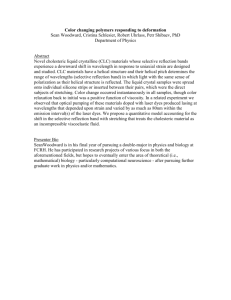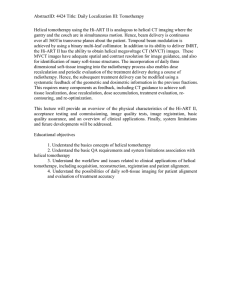
GYNECARE TVT ABBREVO® Continence System
Key Steps
The goal is to keep the point of the needle as close to the bone as possible using the “Stop`, pop, stop, drop, rotate, and hug the
bone” Key Steps.
STEP 1: Position Patient and Mark Reference Points
• Place patient in dorsal lithotomy with hips hyperflexed with the coccyx
flush to the edge of the table.
Note: This positioning ensures there is adequate space to allow the
handle to drop.
• If desired, locate the reference points first by tracing a horizontal line at
the level of the urethral meatus, and then trace a second line parallel
and 2 cm above the first line. Mark the reference points on this second
line, 2 cm lateral to the folds of the thigh.
Note: Do not make an incision at this point in the procedure.
STEP 3: Insert the Winged Guide and Helical Passer
• Insert the Winged Guide into the dissected tract posterior and in
contact with the ischio-pubic ramus and into the obturator internus
muscle, but STOP upon reaching the obturator membrane without
perforating it.
Note: The Insertion Zone on the Winged Guide should remain visible
throughout the procedure.
• The POP: Insert the Helical Passer inward along the Winged Guide
until you perforate the obturator membrane (determined by a palpable
pop), which confirms that the membrane has been penetrated.
STOP again.
• Once in this position, remove the Winged Guide.
STEP 5: ROTATE the Helical Passer
• ROTATE the Helical Passer, HUGGING THE BONE (ischio-pubic ramus),
until the skin is tented.
Note: Hugging the ischio-pubic ramus will help the Helical Passer exit
inferior and medial to the reference points defined in Step 1.
STEP 2: Make Vaginal Incision and Dissect
• Using Allis clamps for traction, make a 1 cm midline vaginal incision at
the point of the mid-urethra.
• Initiate using sharp dissection.
• With the scissors oriented on the horizontal plane, dissect from
the vaginal incision using a “push-spread” technique to the inferior
pubic ramus.
• Continue dissection just past the ischio-pubic ramus and into the
obturator internus muscle, but do not perforate the obturator membrane.
Note: The aim of the dissection is to create a channel that is just wide
enough for insertion of the Winged Guide without perforating the
obturator membrane.
STEP 4: DROP the Handle towards Midline
• Take care not to advance the needle tip yet.
• Reposition the handle of the Helical Passer by DROPPING it towards
the midline until the handle is nearly vertical to the floor.
STEP 6: Pass through Skin
• Stabilize the skin.
Note: The tip of the Helical Passer may exit medially to the previously
marked points.
• If desired, make skin incision at the point where the tip of the Helical
Passer tents the skin.
• Fully rotate the Helical Passer until the tip of the Helical Passer Sheath
appears at the skin.
GYNECARE TVT ABBREVO® Continence System
STEP 7: Remove the Helical Passer
• Grasp the exposed tip of the Helical Passer Sheath with a clamp.
• Stabilize the Helical Passer Sheath near the urethra and remove the
Helical Passer with a reverse rotation of the handle.
STEP 9: Repeat Steps 2-8 on Patient’s Other Side
• Repeat the technique on the patient’s other side.
STEP 8: Pull the Helical Passer Sheath through the Skin
• Pull the Helical Passer Sheath completely through the skin until the
initial part of the Plastic Sheath and Positioning Lines appear.
• Ensure that the Mesh and the Plastic Sheath are not twisted.
STEP 10: Position Mesh and Remove Helical Passer Sheaths
• Gently pull on the Mesh Sheath including the Positioning Lines until
the Placement Loop is central to the vaginal incision and the Mesh is in
contact with the urethra.
• Cut off the Helical Passer Sheath on each side of the device beyond the
skin exit points.
STEP 11: Adjust Tension, Remove Plastic Sheath,
and Make Final Adjustments
• Place a blunt instrument (e.g., scissors or forceps) between the urethra
•
•
•
•
and the Mesh and adjust the Mesh while the Plastic Sheaths are still in
place. Note: Use a suitable instrument to avoid positioning the Mesh
with tension. Do not pull on the Placement Loop for counter-traction as
it may damage the Mesh.
Once the Mesh is adjusted, with the blunt instrument in place, remove
both Plastic Sheaths, taking care not to remove the two sets of
Positioning Lines.
Make final adjustments.
If the Mesh should be loosened, use a blunt instrument. Do not pull on
the Placement Loop for counter-traction.
If additional (minor) adjustments need to be made, determine the
best side to adjust and pull on BOTH ends of the Positioning Lines on
that side to position the Mesh appropriately while maintaining Mesh
symmetry during adjustment.
STEP 12: Remove Positioning Lines and Replacement Loop,
and Then Close
• Remove the Positioning Lines from both skin exit points by gently
pulling on one end of each of the Positioning Lines.
• Remove the Placement Loop by cutting the loop and removing both
the loop and the button from the mesh.
• Before closing the vaginal and skin incisions, ensure that the Plastic
Sheaths, Positioning Lines, Placement Loop and button are removed so
that only the 12cm Mesh remains in the patient.
This information is intended as an overview only. Please
refer to the INSTRUCTIONS FOR USE included with this
device for indications, contraindications, warnings,
precautions and other important information about the
GYNECARE TVT ABBREVO™ Continence System.
© 2016 Ethicon US, LLC. All rights reserved. 013200-160307








